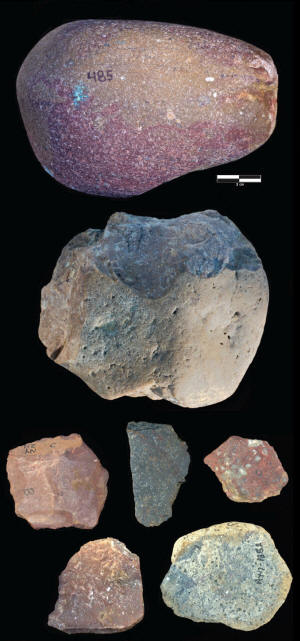'Whodunit' mystery arises over trove of prehistoric Kenyan stone tools
 Send a link to a friend
Send a link to a friend
 [February 10, 2023]
By Will Dunham [February 10, 2023]
By Will Dunham
WASHINGTON (Reuters) - Scientists have a mystery on their hands after
the discovery of 330 stone tools about 2.9 million years old at a site
in Kenya, along Lake Victoria's shores, that were used to butcher
animals, including hippos, and pound plant material for food.
Which of our prehistoric relatives that were walking the African
landscape at the time made them? The chief suspect, researchers said on
Thursday in describing the findings, may be a surprise.
The Nyayanga site artifacts represent the oldest-known examples of a
type of stone technology, called the Oldowan toolkit, that was
revolutionary, enabling our forerunners to process diverse foods and
expand their menu. Three tool types were found: hammerstones and stone
cores to pound plants, bone and meat, and sharp-edged flakes to cut
meat.
To put the age of these tools into perspective, our species Homo sapiens
did not appear until roughly 300,000 years ago.
Scientists had long believed Oldowan tools were the purview of species
belonging to the genus Homo, a grouping that includes our species and
our closest relatives. But no Homo fossils were found at Nyayanga.
Instead, two teeth - stout molars - of a genus called Paranthropus were
discovered there, an indication this prehistoric cousin of ours may have
been the maker.
"The association of these Nyayanga tools with Paranthropus may reopen
the case as to who made the oldest Oldowan tools. Perhaps not only Homo,
but other kinds of hominins were processing food with Oldowan
technology," said anthropologist Thomas Plummer of Queens College in New
York City, lead author of the research published in the journal Science.
The term hominin refers to various species considered human or closely
related.

"When our team determined the age of the Nyayanga evidence, the
perpetrator of the tools became a 'whodunit' in my mind," said
paleoanthropologist and study co-author Rick Potts, director of the
Smithsonian National Museum of Natural History's Human Origins Program.
"There are several possibilities. And except for finding fossilized hand
bones wrapped around a stone tool, the originator of the early Oldowan
tools may be an unknown for a long time."
The molars represent the oldest-known fossils of Paranthropus, an
upright-walker that combined ape-like and human-like traits, possessing
adaptations for heavy chewing, including a skull topped with a bony
ridge to which strong jaw muscles were attached, like in gorillas.
Other hominins existing at the time included the genus Australopithecus,
known for the famous even-older fossil "Lucy."
"While some species of nonhuman primates produce technologies that
assist in foraging, humans are uniquely dependent on technology for
survival," Plummer said.
[to top of second column]
|

Examples of an Oldowan percussive tool,
core and flakes dating from roughly 2.9 million years ago and found
at the Nyayanga site in Kenya are seen in this undated handout
image. (Top row) Percussive tool found in 2016. (Second row from
top) Oldowan core found in 2017. (Bottom rows) Oldowan flakes found
in 2016 and 2017. The analysis of wear patterns on 30 of the stone
tools found at the site showed that they had been used to cut,
scrape and pound both animals and plants. T.W. Plummer, J.S. Oliver,
and E. M. Finestone, Homa Peninsula Paleoanthropology
Project/Handout via REUTERS

All later developments in prehistoric technologies were based on
Oldowan tools, making their advent a milestone in human evolution,
Potts said. Rudimentary stone tools 3.3 million years old from
another Kenyan site may have been an Oldowan forerunner or a
technological dead-end.
The Nyayanga site today is a gully on Homa Mountain's western flank
along Lake Victoria in southwestern Kenya. When the tools were made,
it was woodland and grassland along a stream, teeming with animals.
Until now, the oldest-known Oldowan examples dated to around 2.6
million years ago, in Ethiopia. The species Homo erectus later toted
Oldowan technology as far as Georgia and China.
Cut marks on hippopotamus rib and shin bones at Nyayanga were the
oldest-known examples of butchering a very large animal - called
megafauna. The researchers think the hippos were scavenged, not
hunted. The tools also were used for cracking open antelope bones to
obtain marrow and pounding hard and soft plant material.
Fire was not harnessed until much later, meaning food was eaten raw.
The researchers suspect the tools were used to pound meat to make it
like "hippo tartare."
"Megafauna provide a super abundance of food," Plummer said. "A
hippopotamus is a big leather sack full of good things to eat."
(Reporting by Will Dunham, Editing by Rosalba O'Brien)
[© 2023 Thomson Reuters. All rights
reserved.]This material may not be published,
broadcast, rewritten or redistributed.
Thompson Reuters is solely responsible for this content.
 |